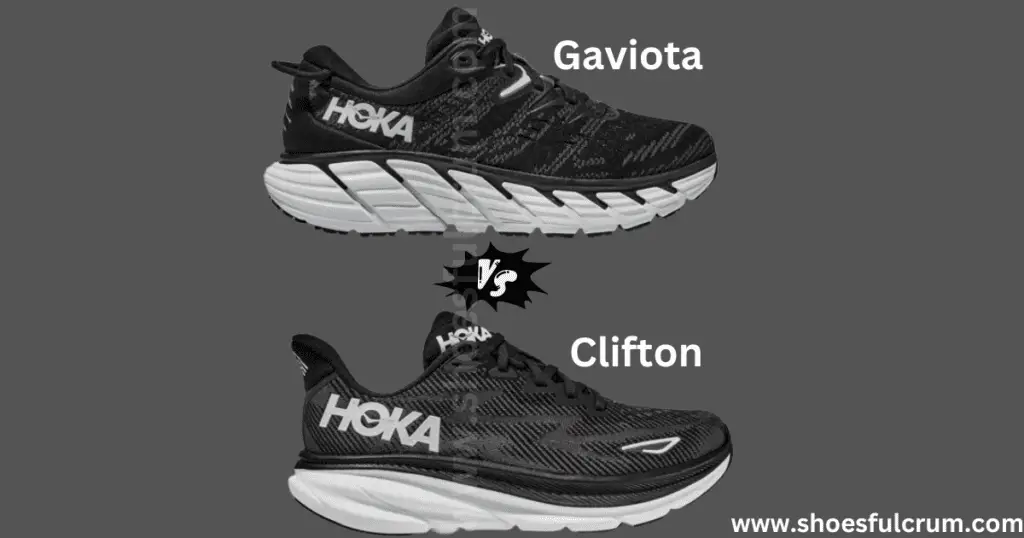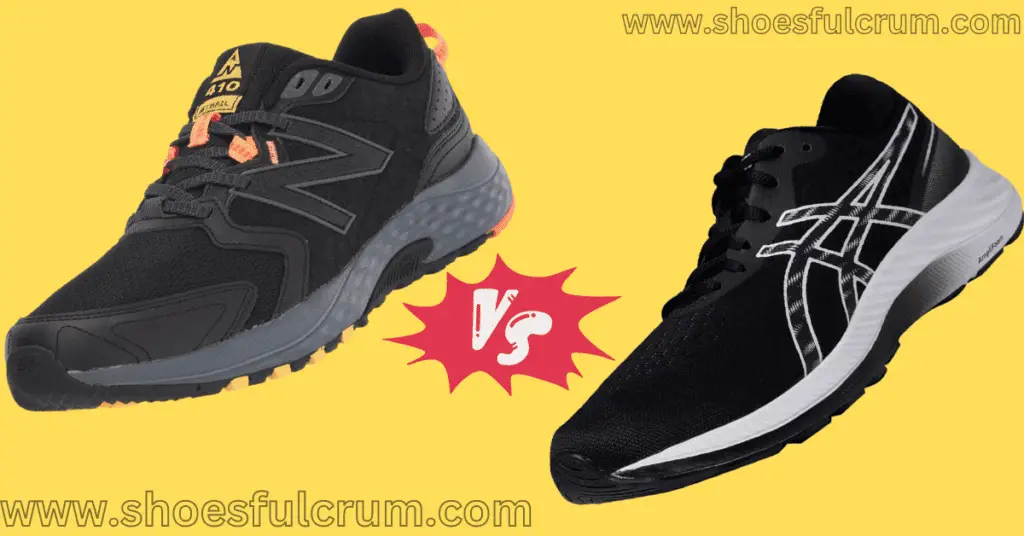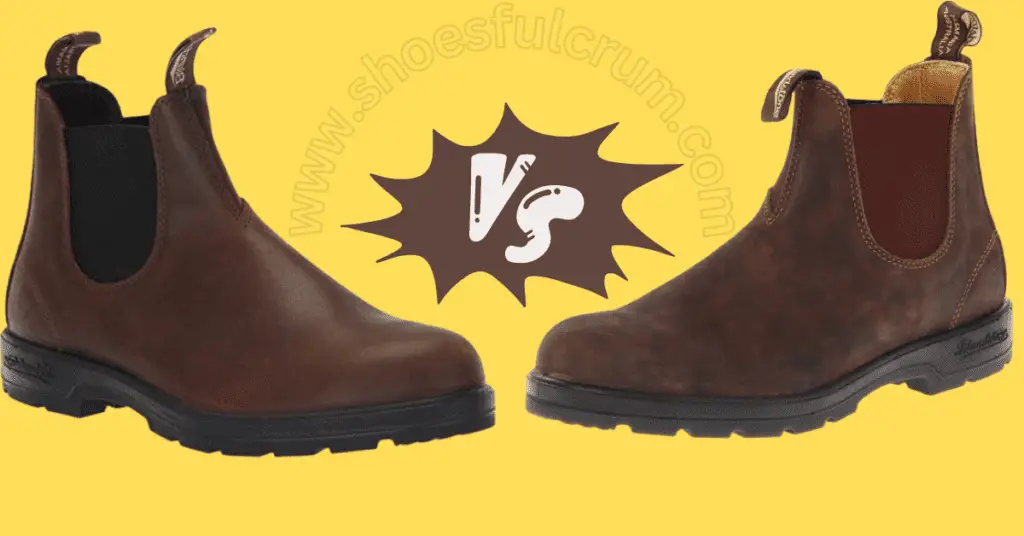As a passionate runner, I fully understand the importance of having the perfect pair of running shoes that can enhance my performance and keep me comfortable mile after mile. With numerous options available in the market, it can be overwhelming to choose the right shoe that caters to your running style and preferences.
In my pursuit of finding the ultimate running shoe, I have come across two popular contenders: Hoka Gaviota and Clifton.
Both Hoka Gaviota and Clifton are highly acclaimed running shoe models that have piqued the interest of athletes and enthusiasts alike. Each shoe offers its unique features and benefits, catering to different types of runners with specific needs.
Selecting an ideal running shoe requires consideration of several factors such as cushioning, stability, support, overall comfort, durability, weight, and responsiveness – all crucial elements that can significantly impact your running experience on both roads or trails.
Whether you’re a long-distance runner seeking maximum cushioning or a speed enthusiast looking for a lightweight shoe – this article will shed light on which model reigns supreme in meeting your specific running requirements.
So let’s dive into the world of Hoka Gaviota and Clifton models – unraveling their unique features and benefits to discover which one will accompany you on your next run while providing an optimal blend of comfort, support, and performance.
Major differences between Hoka Gaviota vs Clifton
| Aspect | Hoka Gaviota | Hoka Clifton |
|---|---|---|
| Fit | Roomy toe box, supportive midfoot | The roomy toe box, supportive midfoot |
| Comfort | The roomy toe box, accommodating fit | Responsive cushioning, comfortable ride |
| Performance | Stability support, ideal for overpronation | Versatile performance on roads |
| Durability | Durable construction, long-lasting | Good durability, suitable for regular use |
| Running Surfaces | Suitable for road, trail, and track | Primarily for road running |
| Price | Slightly higher retail price | Moderate retail price |
| Value | Cost-effective, offers durability | Good value for its performance and comfort |
| Heel Pain | Provides support and shock absorption | Provides comfort, but consult a professional |
| Wide Feet | Accommodating fit for wide feet | Accommodating fit for wide feet |
| Color Variations | Limited color options | Wide range of color options |
| Daily Trainer | Suitable for regular training | Ideal for daily training |
| Gym Use | Can be used for light gym workouts | Not specifically designed for gym use |
| Wet Conditions | Good traction and grip | Decent performance, exercise caution |
| Racing | Suitable for longer races | Can be used for shorter races |
| Arch Support | Provides good arch support | Moderate arch support |
| Pronation Support | Suitable for overpronators | Neutral support |
| Terrain Compatibility | Suitable for various terrains | Primarily for road surfaces |
Hoka Gaviota vs Clifton: Fit Comparison
I will compare their fit based on three key aspects:
- Upper Construction And Materials
- Toe Box Width And Roominess
- Heel and Midfoot Lockdown
Let’s dive in and explore how these two shoes differ in terms of fit.
1) Upper Construction And Materials
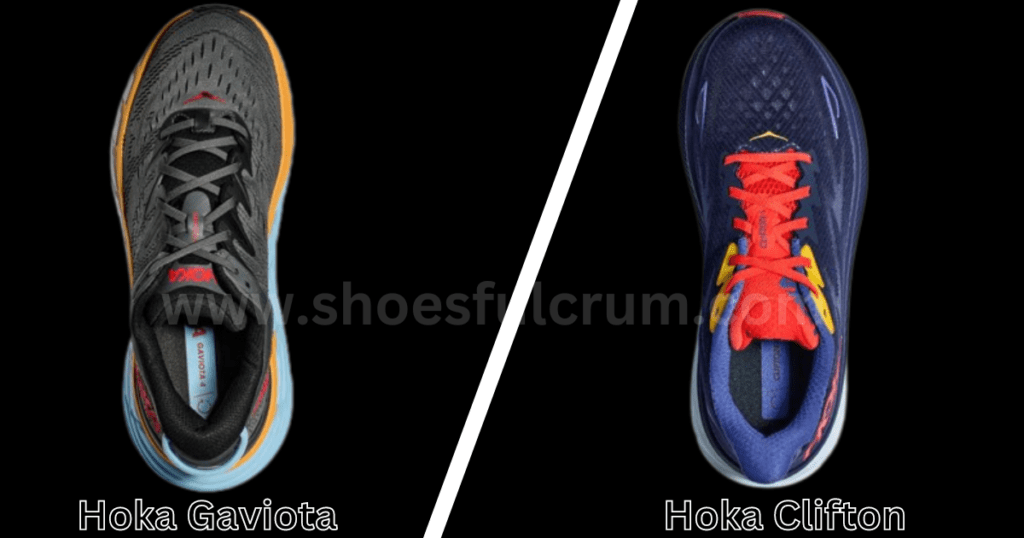
The upper construction and materials play a significant role in determining the fit and overall comfort of a running shoe. When comparing the Gaviota and Clifton, there are notable differences in their upper designs.
Hoka Gaviota
The Gaviota features a more structured and supportive upper.
It utilizes sturdy overlays and a firmer mesh material, which enhances stability and provides a snug fit around the foot.
The upper of the Gaviota offers a secure and locked-in feeling, making it suitable for runners who prefer a more contained fit.
Hoka Clifton
On the other hand, the Clifton boasts a more lightweight and breathable upper construction.
It incorporates a breathable mesh material that allows for ample airflow, keeping the foot cool during runs.
The upper of the Clifton offers a more relaxed fit, providing a sense of freedom and flexibility.
2) Toe Box Width And Roominess
The width and roominess of the toe box can greatly impact the comfort and fit of a running shoe. Some runners prefer a snug and narrow fit, while others require more space in the toe area.
Let’s see how the Gaviota and Clifton differ in this aspect.
Hoka Gaviota
The Gaviota tends to have a wider toe box compared to the Clifton.
This allows for more room for toe splay, accommodating runners with wider feet or those who prefer a more spacious fit.
The extra width in the toe box provides a comfortable and natural feel, minimizing any potential discomfort or pressure points.
Hoka Clifton
On the other hand, the Clifton has a slightly narrower toe box compared to the Gaviota.
This provides a more streamlined and snug fit for runners who prefer a closer and more secure feel around the toes.
While the Clifton may not offer as much room for toe splay, it still provides enough space for most runners, especially those with average or narrower feet.
3) Heel And Midfoot Lockdown
A secure and stable fit in the heel and midfoot is essential for preventing slippage and ensuring a smooth running experience. Let’s compare the heel and midfoot lockdown of the Gaviota and Clifton.
Hoka Gaviota
The Gaviota excels in providing a secure and locked-in feel in the heel and midfoot areas.
Its structured upper and strategically placed overlays offer excellent stability, keeping the foot in place and minimizing any unwanted movement during runs.
This feature is particularly beneficial for runners who require added support and stability in these areas.
Hoka Clifton
The Clifton, while still providing a secure fit, offers a more relaxed and forgiving feel in the heel and midfoot.
Its lightweight upper construction allows for a more natural foot movement and a comfortable fit without compromising on stability.
Clifton’s design ensures a secure fit without feeling overly restrictive.
Hoka Gaviota VS Clifton: Comfort
Comfort is a crucial factor when it comes to choosing the right running shoe. Now, I will compare the comfort levels of the Hoka Gaviota and Clifton based on three key aspects:
- Cushioning Level And Responsiveness
- Arch Support And Stability
- Impact Absorption And Shock Attenuation
Let’s dive into these features and explore how these two models differ in terms of comfort.
1) Cushioning Level And Responsiveness
Cushioning plays a significant role in determining the overall comfort of a running shoe. The Gaviota and Clifton offer distinct approaches to cushioning, catering to different preferences.
Hoka Gaviota
The Gaviota is renowned for its maximum cushioning, providing a plush and pillowy feel underfoot.
This abundant cushioning effectively absorbs the impact of each foot strike, reducing stress on the joints and minimizing fatigue.
The Gaviota’s cushioning excels in providing a luxurious and comfortable ride, making it ideal for long-distance runners or those seeking superior shock absorption.
Hoka Clifton
On the other hand, Clifton strikes a balance between cushioning and responsiveness.
Its midsole incorporates a layer of cushioning that offers adequate impact protection while still maintaining a level of responsiveness.
This design feature ensures a snappy and energetic feel during runs, allowing for a more dynamic and engaging experience.
2) Arch Support And Stability
Proper arch support and stability are crucial for maintaining a comfortable and secure fit, especially for runners with specific foot conditions or pronation tendencies.
Let’s compare the arch support and stability of the Gaviota and Clifton.
Hoka Gaviota
The Gaviota stands out in this aspect with its exceptional arch support.
It features a supportive J-Frame technology that wraps around the foot, providing structure and stability to the arch area.
This design promotes a more efficient foot alignment and helps reduce the risk of overpronation or excessive inward rolling of the foot.
Hoka Clifton
The Clifton also offers a level of arch support, although it may be slightly less pronounced compared to the Gaviota.
However, Clifton compensates with its overall stability. The shoe’s construction and midsole design provides a stable platform, ensuring a secure and confident stride.
Runners who value stability without sacrificing overall comfort will appreciate Clifton’s reliable support.
3) Impact Absorption And Shock Attenuation
The ability of a running shoe to absorb and attenuate impact is crucial for preventing discomfort and potential injuries.
Let’s see how the Gaviota and Clifton differ in terms of impact absorption and shock attenuation.
Hoka Gaviota
The Gaviota’s maximum cushioning not only provides exceptional comfort but also excels in absorbing and dispersing impact forces.
Each footstrike is met with ample cushioning, effectively reducing the stress on joints and muscles.
This feature is particularly beneficial for runners who require additional protection or those who are prone to injuries such as shin splints or stress fractures.
Hoka Clifton
Similarly, Clifton offers reliable impact absorption and shock attenuation.
Although it may not have the same level of cushioning as the Gaviota, its midsole and foam materials still provide adequate protection against impact.
The Clifton’s responsive cushioning helps dissipate the shock of each stride, offering a comfortable and smooth running experience.
Hoka Gaviota VS Clifton: Performance Analysis
When it comes to performance, choosing the right running shoe can significantly impact your running experience. Let’s analyze the performance of the Hoka Gaviota and Clifton in three key areas:
- Long-Distance Running
- Speed And Agility
- Traction And Grip
Let’s see how these two models compare in terms of performance.
1) Long-Distance Running
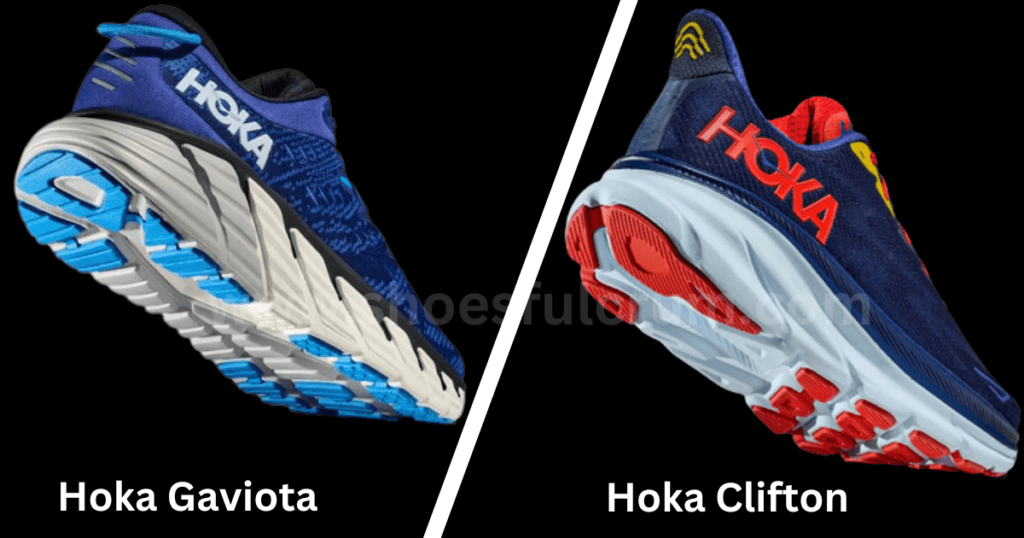
For runners who tackle long-distance runs, endurance, and comfort are essential. Let’s see how Gaviota and Clifton perform in this aspect.
Hoka Gaviota
The Gaviota is a reliable companion for long-distance running. Its maximum cushioning and plush midsole provide excellent shock absorption, minimizing fatigue and discomfort over extended periods.
The shoe’s supportive structure and stable platform contribute to a smooth and efficient stride, allowing you to maintain a consistent pace mile after mile.
The Gaviota’s emphasis on comfort and stability makes it an excellent choice for those looking to conquer marathons or engage in long training runs.
Hoka Clifton
Similarly, Clifton also performs admirably in long-distance running. While it may have slightly less cushioning than the Gaviota, its lightweight design and responsive midsole offer a more energetic and agile feel.
Clifton’s ability to maintain a good balance between cushioning and responsiveness allows for a comfortable and efficient performance during longer runs.
It keeps you feeling light on your feet without sacrificing the necessary support for extended distances.
2) Speed And Agility
When it comes to speed and agility, a running shoe needs to provide the necessary responsiveness and flexibility.
Let’s assess the performance of Gaviota and Clifton in this regard.
Hoka Gaviota
The Gaviota, with its maximum cushioning, excels in providing a stable and supportive platform, which is advantageous for runners who prioritize stability over speed.
While it may not be the most lightweight option, its construction allows for a controlled and smooth ride.
The Gaviota’s J-Frame support system ensures proper foot alignment, enhancing stability during quick directional changes.
This feature makes it suitable for runners who value stability and support during high-intensity training sessions or long-distance races.
Hoka Clifton
On the other hand, Clifton shines when it comes to speed and agility.
Its lightweight design and responsive midsole make it a suitable choice for runners who want to pick up the pace.
The Clifton’s cushioning provides a comfortable yet springy feel, allowing for quick turnover and smooth transitions.
The shoe’s versatility in various running styles allows for dynamic and agile movements, making it a great option for speed workouts, intervals, or races where responsiveness is key.
3) Traction And Grip
Traction and grip are vital for maintaining control and confidence, particularly when running on diverse surfaces.
Let’s compare the performance of the Gaviota and Clifton in terms of traction and grip.
Hoka Gaviota
The Gaviota offers reliable traction and grip, thanks to its durable rubber outsole with multidirectional lugs.
This design ensures a secure footing on both dry and wet surfaces, providing the necessary confidence to tackle different terrains.
Whether you are running on roads, trails, or even in inclement weather conditions, the Gaviota’s traction keeps you feeling stable and in control.
Hoka Clifton
Similarly, the Clifton boasts a well-designed outsole that delivers solid traction.
The strategic placement of rubber pods and grooves enhances grip on various surfaces, promoting a confident stride.
While it may not have the same level of aggressive traction as some trail-specific shoes, Clifton’s grip is more than sufficient for most road or light trail running adventures.
Hoka Gaviota VS Clifton: Durability
Durability is also a crucial factor to consider when investing in a running shoe.
As a dedicated runner, I expect my shoes to withstand the rigors of training and provide long-lasting performance. Now, In this section, I will compare the durability of the Hoka Gaviota and Clifton in three key aspects:
- Outsole Material And Wear Resistance
- Upper Construction And Wear And Tear
- Midsole Compression And Longevity
Let’s explore how these two models differ in terms of durability.
1) Outsole Material And Wear Resistance
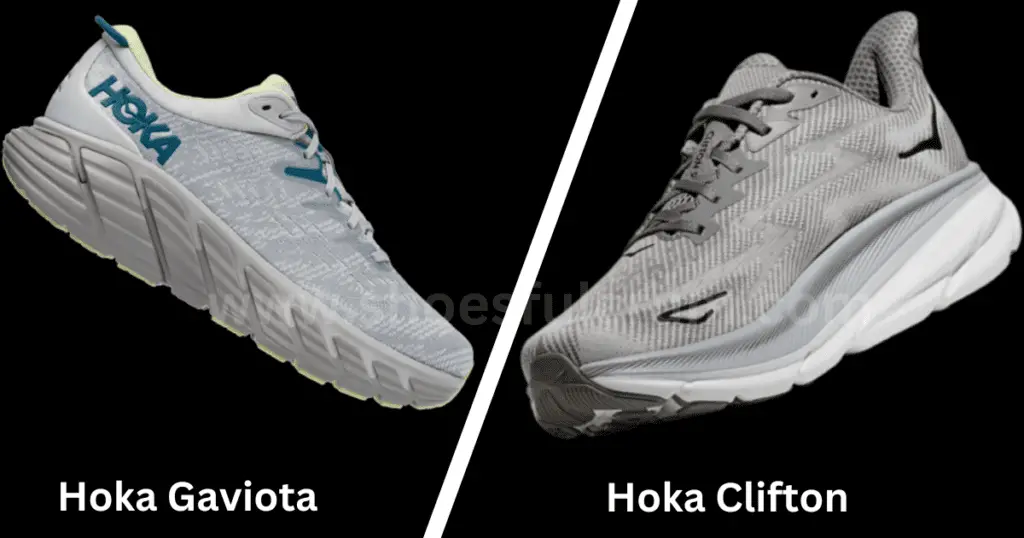
The outsole of a running shoe is exposed to constant friction and impact, making it essential to have a durable and wear-resistant material. Let’s see how the Gaviota and Clifton fare in this aspect.
Hoka Gaviota
The Gaviota features a durable rubber outsole that exhibits excellent wear resistance.
The rubber compound used in its outsole construction is designed to withstand the abrasion of regular use, making it a reliable option for long-term durability.
Whether you are running on roads, trails, or even rough surfaces, the Gaviota’s outsole shows minimal signs of wear resistance, providing confidence in its long-lasting performance.
Hoka Clifton
Similarly, the Clifton incorporates a high-quality rubber outsole that exhibits impressive durability.
The outsole material is engineered to resist wear and maintain its traction over extended periods.
Despite its lightweight design, Clifton’s outsole holds up well against the demands of regular training, ensuring that the shoe remains reliable and durable over time.
2) Upper Construction And Wear-And-Tear
The upper of a running shoe plays a vital role in providing support, comfort, and protection.
Let’s compare the upper constructions of the Gaviota and Clifton in terms of their durability.
Hoka Gaviota
The Gaviota features a well-constructed upper that utilizes durable materials.
The overlays and reinforced sections add strength and resilience to the shoe’s structure, making it more resistant to wear and tear.
The Gaviota’s upper withstands repeated flexing and stretching, maintaining its shape and integrity even after extended use.
This durability ensures that the shoe remains supportive and secure throughout its lifespan.
Hoka Clifton
Likewise, Clifton’s upper construction exhibits durability and resilience.
Although it prioritizes breathability and lightweight design, the upper materials are engineered to withstand the stresses of running.
Clifton’s construction strikes a good balance between durability and performance, ensuring that the shoe can handle regular training without compromising comfort or support.
3) Midsole Compression And Longevity
The midsole of a running shoe provides cushioning and impact absorption, and its ability to retain its properties over time is crucial for long-term durability. Let’s assess the midsole compression and longevity of the Gaviota and Clifton.
Hoka Gaviota
The Gaviota’s midsole demonstrates excellent resistance to compression, even after extensive use.
The cushioning materials employed in its construction maintain their responsiveness and shock-absorbing capabilities, ensuring a consistent and comfortable ride.
The Gaviota’s midsole shows minimal signs of compression, allowing it to retain its cushioning properties and provide lasting support throughout its lifespan.
Hoka Clifton
Similarly, Clifton’s midsole exhibits impressive longevity and resistance to compression.
The foam materials used in its construction maintain their responsiveness and cushioning even after repeated use.
The Clifton’s midsole holds up well over time, delivering a comfortable and supportive running experience throughout its lifespan.
Hoka Gaviota VS Clifton: Running Experience
As a passionate runner, finding the right shoe that enhances my running experience is of utmost importance. In this section, I will delve into the running experience provided by Hoka Gaviota and Clifton, focusing on three key aspects:
- Running Gait And Pronation Support
- Terrain Compatibility
- Ideal Running Conditions
Let’s explore how these two models differ and which one suits your running needs.
1) Running Gait And Pronation Support
Understanding your running gait and pronation is crucial when choosing a running shoe that provides the necessary support and alignment.
Let’s compare how the Gaviota and Clifton cater to different running gaits and pronation types.
Hoka Gaviota
The Gaviota is designed with overpronators in mind. Its supportive J-Frame technology provides excellent arch support and helps control excessive inward rolling of the foot.
This feature ensures proper alignment and reduces the risk of common overpronation-related injuries.
If you tend to overpronate or require additional stability, the Gaviota offers the necessary support to promote a more efficient and comfortable running gait.
Hoka Clifton
On the other hand, the Clifton offers a more neutral platform suitable for runners with a neutral or slightly underpronated gait.
While it may not have the same level of pronation support as the Gaviota, its cushioning and responsive midsole provide a comfortable and adaptable running experience.
If you have a neutral gait or require less stability support, the Clifton offers a balanced and responsive ride.
2) Terrain Compatibility
Different running shoes excel in different terrains, so it’s essential to consider the type of terrain you typically run on. Let’s see how the Gaviota and Clifton fare in terms of terrain compatibility.
Hoka Gaviota
The Gaviota performs exceptionally well on roads and paved surfaces.
Its durable rubber outsole provides reliable traction and grip, ensuring a secure footing on these types of terrains.
Whether you’re logging miles on the city streets or running on well-maintained paths, the Gaviota offers the necessary stability and support for a comfortable road running experience.
Hoka Clifton
The Clifton, primarily designed for road running, can also handle light trails and packed dirt paths.
Its outsole, although not as aggressive as a trail-specific shoe, still provides decent traction on these surfaces.
However, for more technical trails or rugged terrains, a dedicated trail running shoe would be a better choice.
If you occasionally venture off-road but primarily stick to roads, the Clifton offers versatility for both terrains.
3) Ideal Running Conditions
Each running shoe has its optimal running conditions, depending on its design features. Let’s discuss the ideal running conditions for the Gaviota and Clifton.
Hoka Gaviota
The Gaviota shines during long-distance runs or when comfort and stability are paramount.
Its maximum cushioning and supportive features make it an excellent choice for extended periods on your feet.
Whether you’re tackling marathon training or engaging in high-mileage runs, the Gaviota ensures a comfortable and supported experience.
Hoka Clifton
The Clifton, with its lightweight design and responsive cushioning, thrives in a variety of running conditions.
It excels during tempo runs, speed workouts, or shorter distances where a more agile and energetic feel is desired.
The Clifton’s versatility allows it to adapt to various training intensities and distances, providing a dynamic and engaging running experience.
Choosing The Right Shoe For You: Hoka Gaviota VS Clifton
When it comes to choosing the ideal running shoe, it is essential to take into account elements such as your running technique, the shape of your foot, and particular needs.
Being a runner myself, I acknowledge the significance of discovering a shoe that meets your demands and tastes.
Now, I will offer guidance on choosing between the Hoka Gaviota and Clifton, providing recommendations for different types of runners. Let’s explore which shoe might be the right fit for you.
Neutral Runners Seeking Comfort And Cushioning
If you’re a neutral runner in search of comfort and plush cushioning, both the Hoka Gaviota and Clifton have a lot to offer. However, there are some key differences to consider.
Hoka Gaviota
The Gaviota caters to neutral runners who desire maximum cushioning and support. Its J-Frame support system provides stability and helps correct overpronation, making it suitable for those who need a little extra support.
The Gaviota’s generous cushioning offers a plush and protective feel, ideal for longer runs or runners who prioritize ample cushioning for joint comfort.
Hoka Clifton
The Clifton is known for its lightweight design, responsive cushioning, and versatility.
It provides a balanced combination of comfort and performance, making it an excellent choice for neutral runners seeking a smooth and energetic ride.
Clifton’s cushioning offers a responsive feel without compromising on impact absorption, allowing for a comfortable and enjoyable running experience.
Overpronators Requiring Stability And Support
For overpronators, finding a shoe that offers stability and support is crucial to maintaining proper foot alignment and preventing potential injuries.
In this case, the Hoka Gaviota is the recommended choice between the two models.
The Gaviota’s J-Frame support system is specifically designed to provide stability for overpronators.
It helps guide the foot through a natural and controlled motion, reducing excessive inward rolling of the foot.
This support system, combined with the shoe’s maximum cushioning, offers the necessary stability and comfort for overpronators during their runs.
Long-Distance Runners Prioritizing Durability And Longevity
Long-distance runners who prioritize durability and longevity are in search of a shoe that can endure the rigors of their training and deliver lasting performance.
Both the Gaviota and Clifton offer suitable choices for this category. However, it is important to take certain factors into account.
Hoka Gaviota
The Gaviota’s robust construction, durable outsole, and resilient midsole make it a durable choice for long-distance running.
Its ability to maintain its cushioning and support over time ensures that it remains reliable during your extended training sessions and races.
If durability and longevity are high on your priority list, then in my experience Gaviota is the recommended option.
Hoka Clifton
On the other hand, the Clifton offers good durability while still maintaining a lightweight design.
Its outsole provides adequate wear resistance for road running, and the shoe’s upper construction is built to withstand regular use.
Although not specifically designed for maximum durability, the Clifton still offers longevity that can meet the demands of long-distance running.
Performance On Different Running Surfaces: Hoka Gaviota VS Clifton
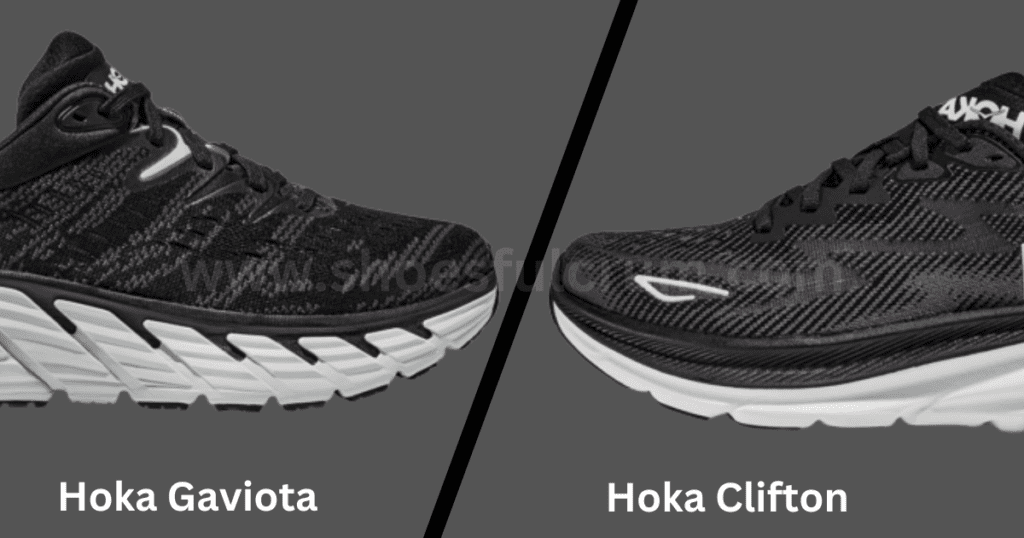
As runners, we often encounter various terrains during our training sessions and races. The ability of a running shoe to perform well on different surfaces is a crucial factor to consider when making a choice.
Now, I will assess the performance of the Hoka Gaviota and Clifton on three common surfaces
- Road Running
- Trail Running
- Track Running
By evaluating their characteristics and design, we can determine which shoe is better suited for each terrain.
Performance Of The Hoka Gaviota
First I will only discuss Hoka Gaviota. Let’s see how this shoe performs on different surfaces.
1) Road Running
The Hoka Gaviota demonstrates excellent performance on road surfaces. Its outsole, made of durable rubber, provides reliable traction and grip on asphalt or concrete.
The shoe’s wide base enhances stability, while the meta-rocker technology promotes a smooth heel-to-toe transition, allowing for an efficient stride.
The Gaviota’s cushioning offers optimal shock absorption, reducing the impact on joints during road runs.
2) Trail Running
While the Gaviota is primarily designed for road running, it can still handle light trail running.
However, it is important to note that the shoe’s traction on loose or technical trails may not be as robust as a dedicated trail running shoe.
The Gaviota’s outsole, although durable, lacks aggressive lugs that provide optimal grip on uneven or slippery terrain.
For moderate trail running, such as well-groomed paths or dirt trails, the Gaviota can still deliver a comfortable and supportive experience.
3) Track Running
On the track, where speed and agility are key, the Gaviota may not be the most suitable choice.
Its maximum cushioning and stability features, while beneficial for longer distances, can impede the responsiveness and quick turnover required for track running.
For track workouts or races, a lighter and more flexible shoe, such as a dedicated racing flat or lightweight trainer, would be a better option.
Performance Of The Clifton
After knowing the performance of Hoka Gaviota now let’s see how Hoka Clifton performs on different surfaces.
1) Road Running
The Clifton is renowned for its performance on road surfaces.
Its lightweight design and responsive cushioning make it an ideal choice for road runners.
The shoe’s EVA foam midsole provides a comfortable and energetic ride, absorbing the impact while providing a spring-like response.
The Clifton’s outsole, although not aggressively patterned, offers adequate traction and durability for road running, ensuring a smooth and enjoyable experience.
2) Trail Running
Similar to the Gaviota, the Clifton is not specifically designed for trail running but can handle light trails and well-groomed paths.
The shoe’s lightweight construction and responsive cushioning contribute to a comfortable ride on moderate trails.
However, Clifton’s outsole may not provide the same level of traction and grip as a dedicated trail running shoe.
For technical or challenging trails, I would advise you to opt for a shoe with more aggressive lugs and sturdier construction.
3) Track Running
Like the Gaviota, the Clifton may not be the optimal choice for track running due to its cushioning and stability features.
However, for track workouts or races that require a balance of cushioning and responsiveness, the Clifton can still perform adequately.
Its lightweight design and energy-returning midsole can contribute to a smooth stride and decent speed on the track.
Comparison Of Performance Of Hoka Gaviota VS Clifton
In comparing the performance of the Hoka Gaviota and Clifton across different terrains, it is evident that both shoes excel on road surfaces.
The Gaviota offers maximum cushioning and stability for road running, while the Clifton provides a lightweight and responsive experience.
When it comes to trail running, both shoes can handle light trails, but dedicated trail running shoes are recommended for more challenging terrain.
For track running, lighter and more flexible shoes are preferred, such as racing flats or lightweight trainers.
Pros And Cons
Hoka Gaviota and Hoka Clifton have the following Pros and cons.
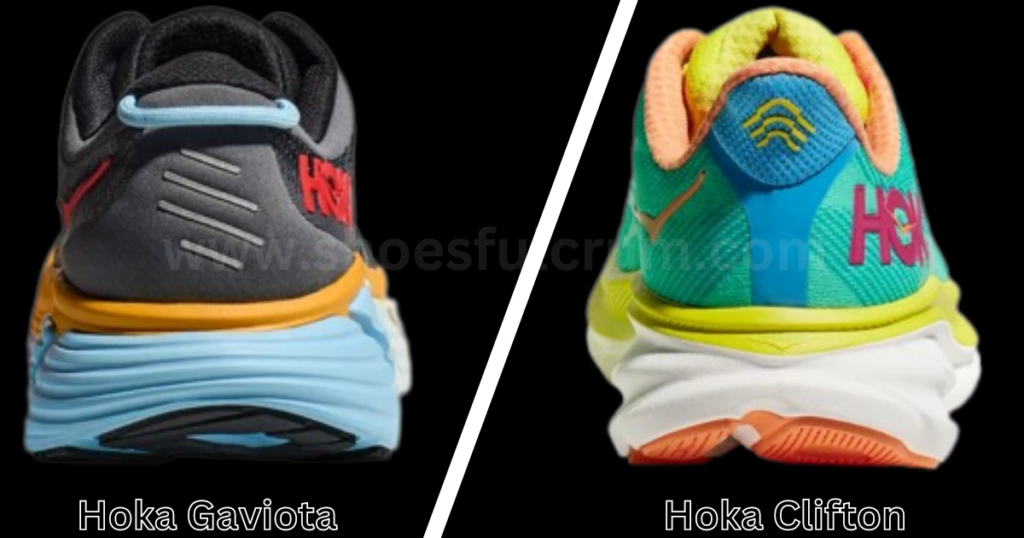
Hoka Gaviota
| Pros | Cons |
|---|---|
| Maximum cushioning | Heavyweight |
| Stability support | Limited color options |
| Comfortable fit | Less versatile |
| Excellent shock absorption | |
| Durable construction | |
| Arch support | |
| Generous toe box |
Hoka Clifton
| Pros | Cons |
|---|---|
| Lightweight design | Less stability support |
| Responsive cushioning | Moderate traction on trails |
| Versatile performance | Limited durability on rugged terrains |
| Breathable upper | |
| Smooth heel-to-toe transition | |
| Attractive aesthetics | |
| Wide range of sizes |
Conclusion
After analyzing the Hoka Gaviota and Clifton across various factors such as fit, comfort, performance, durability, and running surface, it is clear that both shoes have their own strengths and weaknesses.
The Gaviota offers excellent stability and support for overpronators, while the Clifton is better suited for neutral runners seeking maximum comfort and cushioning.
In terms of performance on different surfaces, the Gaviota performs better on trails and tracks, while the Clifton excels on roads.
When it comes to price, the Gaviota is slightly more expensive than the Clifton, but both shoes offer good value for their respective price points.
Ultimately, the choice between the Hoka Gaviota and Clifton will depend on your preferences and needs. I recommend trying on both shoes and seeking expert advice if necessary before making a final decision.
Based on my analysis, I would recommend the Hoka Gaviota for overpronators who require stability and support, as well as long-distance runners who prioritize durability. The Clifton is ideal for neutral runners seeking maximum comfort and cushioning on roads.
Frequently Asked Questions
Is the Hoka Gaviota suitable for flat feet?
Yes, the Hoka Gaviota is a good option for people who have flat feet. It provides exceptional arch support and stability, which helps in good foot alignment and prevents excessive pronation. The Gaviota’s J-Frame support system and cushioning work together to give flat-footed runners the required support and comfort.
What is the function of Hoka Clifton?
The Hoka Clifton is a flexible running shoe that thrives on the road. Its lightweight construction, responsive cushioning, and smooth heel-to-toe transition make it an excellent choice for neutral runners looking for a comfortable and cushioned ride on a variety of road conditions.
Is the Hoka Clifton appropriate for heel pain?
While individual results may vary, many runners find that the Hoka Clifton gives significant heel pain alleviation. The shoe’s considerable cushioning and shock absorption capabilities aid in reducing heel impact, resulting in a more comfortable running experience. However, for a full diagnosis and individualized guidance on heel pain, it is best to consult with a healthcare specialist.
Are the Hoka Gaviota and Clifton shoes acceptable for people with wide feet?
Yes, both the Hoka Gaviota and the Clifton are noted for their spacious toe boxes and accommodating fit, making them ideal for people who have wide feet. These shoes’ wide structure allows for optimum toe splay and a comfortable fit for runners with wider feet.
Are there any color options for the Hoka Gaviota and Clifton?
Yes, both the Hoka Gaviota and the Clifton are available in a range of colors. Hoka offers new color combinations for its shoes on a regular basis, giving runners a variety of options to suit their unique style preferences.
Is Hoka Clifton a regular trainer?
Yes, many runners utilize the Hoka Clifton as their daily trainer. Its lightweight design, cushioning, and adaptability make it ideal for long-distance running and regular training runs. However, when choosing a daily trainer, it’s crucial to consider individual preferences and demands, as some runners may choose a different shoe based on their personal needs.
Is the Hoka Clifton suitable for the gym?
While the Hoka Clifton is primarily intended for running, some people may want to use it for mild gym exercises as well. Cushioning and comfort in the shoe can give support during low-impact activities or cross-training workouts. However, specialist gym shoes that provide the required support and stability are recommended for more strenuous gym workouts or activities that require specific training shoes.
Why is HOKA so popular?
People adore HOKA running shoes for a variety of reasons. HOKA is known for its creative design, which combines maximal cushioning with lightweight construction to provide a one-of-a-kind mix of comfort and performance. The shoes of the company are frequently commended for their superior shock absorption, responsiveness, and support, all of which contribute to a comfortable and enjoyable running experience.
Can I use the Hoka Gaviota or Clifton for racing?
While the Hoka Gaviota and Clifton are intended to be everyday trainers, they can also be utilized for racing depending on personal preference and race distance. The stability attributes of the Gaviota make it suited for longer races where support is necessary, whilst the lightweight design and responsive cushioning of the Clifton may be preferable for shorter races.
How do the Hoka Gaviota and Clifton perform in wet weather?
Because of their outsole designs and materials, the Hoka Gaviota and Clifton both perform well in wet circumstances. The shoes include dependable traction patterns that give hold on wet surfaces, lowering the chance of slipping. Hoka shoes’ outsole rubber compounds are also known for their resilience and traction, even when faced with wet or slippery conditions.

About Author:
Hammad Qadir is a passionate fashion blogger with a passion for shoes, spanning over seven years. As the driving force behind “ShoesFulcrum.com” he offers unparalleled insights into iconic brands like Crocs, Hey Dude, and Birkenstock. With a collection of a hundred pairs, his expertise extends to industry giants like Nike and Adidas. Through insightful reviews and recommendations, Hammad guides readers to their perfect pair. Hammad’s knack for differentiating between brands and guiding readers makes him a trusted authority. Active on Quora, Reddit, Medium, LinkedIn, and Pinterest, he fosters engagement and shares exclusive content. Read more...

